Depth Profiling of Ion-Implanted 4H–SiC Using Confocal Raman Spectroscopy
Abstract
1. Introduction
2. Experimental Setups
2.1. Sample Description
2.2. Measurement Setups
3. Results and Discussion
3.1. Depth Profiling Set-Ups
3.2. Determination of Epitaxial Thicknesses by Depth Profiling
3.3. Depth Profiling of Net Doping Concentration
4. Conclusions
Supplementary Materials
Author Contributions
Funding
Conflicts of Interest
References
- Zhu, L.P.; He, H.P. Wide Band Gap Compound Semiconductor Materials and Devices; Zhejiang University Press: Hangzhou, China, 2016. [Google Scholar]
- Campos, F.J.; Mestres, N.; Alsina, F.; Pascual, J.; Morvan, E.; Godignon, P.; Millán, J. Confocal micro-Raman scattering and Rutherford backscattering characterization of lattice damage in aluminum implanted 6H–SiC. Diam. Relat. Mater. 1998, 8, 357–360. [Google Scholar] [CrossRef]
- Schöner, A.; Karlsson, S.; Schmitt, T.; Nordell, N.; Linnarsson, M.; Rottner, K. Hall Effect Investigations of 4H–SiC Epitaxial Layers Grown on Semi-Insulating and Conducting Substrates. Mater. Sci. Eng. B 1999, 61, 389–394. [Google Scholar] [CrossRef]
- Fukuda, Y.; Nishikawa, K.; Shimizu, M.; Iwakuro, H. Point-Contact Current Voltage Technique for Depth Profiling of Dopants in Silicon Carbide. Mater. Sci. Forum 2002, 389–393, 671–674. [Google Scholar] [CrossRef]
- Chandra, N.; Sharma, V.; Chung, G.Y.; Schroder, D.K. Four-point probe characterization of 4H silicon carbide. Solid State Electron. 2011, 64, 73–77. [Google Scholar] [CrossRef]
- Sherbondy, J.; Hillard, R. Process characterization of low-dose, threshold-voltage adjust channel implants using mercury-probe capacitance–voltage measurements. J. Vac. Sci. Technol. B Microelectron. Nanometer Struct. 2000, 18, 450–453. [Google Scholar] [CrossRef]
- Österman, J.; Hallén, A.; Anand, S.; Linnarsson, M.K.; Andersson, H.; Åberg, D.; Panknin, D.; Skorupa, W. Techniques for Depth Profiling of Dopants in 4H-SiC. Mater. Sci. Forum 2001, 353–356, 559–562. [Google Scholar] [CrossRef]
- Stutz, C.E. Photoelectrochemical Capacitance-Voltage Measurements of 4H-SiC. J. Electron. Mater. 1998, 27, L81–L83. [Google Scholar] [CrossRef]
- Czett, A.; Buday, C.; Savtchouk, S.; Marinskiy, D. Non-contact high precision alternative to Hg-probe for dopant profiling in SiC. Phys. Status Solidi (c) 2014, 11, 1601–1605. [Google Scholar] [CrossRef]
- Giannazzo, F.; Calcagno, L.; Raineri, V.; Ciampolini, L.; Ciappa, M.; Napolitani, E. Quantitative carrier profiling in ion-implanted 6H–SiC. Appl. Phys. Lett. 2001, 79, 1211–1213. [Google Scholar] [CrossRef]
- Linnarsson, M.K.; Hallén, A.; Vines, L. Intentional and unintentional channeling during implantation of 51V ions into 4H-SiC. Semicond. Sci. Technol. 2019, 34, 115006. [Google Scholar] [CrossRef]
- Tabaksblat, R.; Meier, R.J.; KIP, B.J. Confocal Raman Microspectroscopy: Theory and Application to Thin Polymer Samples. Appl. Spectrosc. 1992, 46, 60–68. [Google Scholar] [CrossRef]
- Brink, D.J.; Maurice, T.; Blanque, S.; Kunert, H.; Camassel, J.; Pascual, J. Depth profiling of high energy hydrogen-implanted 6H-SiC. Appl. Opt. 2004, 43, 1275–1280. [Google Scholar] [CrossRef] [PubMed]
- Campos, F.J.; Mestres, N.; Pascual, J.; Morvan, E.; Godignon, P.; Millán, J. Confocal micro-Raman characterization of lattice damage in high energy aluminum implanted 6H-SiC. J. Appl. Phys. 1999, 85, 99–104. [Google Scholar] [CrossRef]
- Żuk, J.; Romanek, J.; Skorupa, W. Micro-Raman depth profile investigations of beveled Al+-ion implanted 6H-SiC samples. Nucl. Instrum. Methods Phys. Res. Sect. B Beam Interact. Mater. At. 2009, 267, 1251–1254. [Google Scholar] [CrossRef]
- De Biasio, M.; Kraft, M.; Schultz, M.; Goller, B.; Sternig, D.; Esteve, R.; Roesner, M. Micro-Raman spectroscopy as a tool for the characterization of silicon carbide in power semiconductor material processing. Next-Gener. Spectrosc. Technol. X 2017, 10210, 1021014. [Google Scholar] [CrossRef]
- Liu, T.; Xu, Z.; Rommel, M.; Wang, H.; Song, Y.; Wang, Y.; Fang, F. Raman Characterization of Carrier Concentrations of Al-implanted 4H-SiC with Low Carrier Concentration by Photo-Generated Carrier Effect. Crystals 2019, 9, 428. [Google Scholar] [CrossRef]
- Kocher, M.; Rommel, M.; Erlbacher, T.; Bauer, A.J. Influence of Al Doping Concentration and Annealing Parameters on TiAl Based Ohmic Contacts on 4H-SiC. Mater. Sci. Forum 2018, 924, 393–396. [Google Scholar] [CrossRef]
- Everall, N.J. Modeling and measuring the effect of refraction on the depth resolution of confocal Raman microscopy. Appl. Spectrosc. 2000, 54, 773–782. [Google Scholar] [CrossRef]
- Xu, Z.W.; Song, Y.; Rommel, M.; Liu, T.; Kocher, M.; He, Z.D.; Wang, H.; Yao, B.T.; Liu, L.; Fang, F.Z. Raman Spectroscopy Characterization of Ion Implanted 4H-SiC. Mater. Sci. Forum 2019, 963, 424–428. [Google Scholar] [CrossRef]
- Harima, H.; Nakashima, S.i.; Uemura, T. Raman scattering from anisotropic LO-phonon–plasmon–coupled mode in n-type 4H– and 6H–SiC. J. Appl. Phys. 1995, 78, 1996–2005. [Google Scholar] [CrossRef]
- Macmillan, M.F.; Henry, A.; Janzén, E. Thickness Determination of Low Doped SiC Epi-Films on Highly Doped SiC Substrates. J. Electron. Mater. 1998, 27, 300–303. [Google Scholar] [CrossRef]
- Oishi, S.; Hijikata, Y.; Yaguchi, H.; Yoshida, S. Simultaneous Determination of Carrier Concentration, Mobility, and Thickness of SiC Homoepilayers by Infrared Reflectance Spectroscopy. Jpn. J. Appl. Phys. 2006, 45, L1226–L1229. [Google Scholar] [CrossRef]
- Li, Z.Y.; Sun, J.W.; Zhang, Y.M.; Zhang, Y.M.; Tang, X.Y. Methods for Thickness Determination of SiC Homoepilayers by Using Infrared Reflectance Spectroscopy. Chin. Phys. Lett. 2010, 27, 068103. [Google Scholar]
- Dong, L.; Sun, G.-S.; Zheng, L.; Liu, X.-F.; Zhang, F.; Yan, G.-G.; Zhao, W.-S.; Wang, L.; Li, X.-G.; Wang, Z.-G. Characterization of 4H–SiC substrates and epilayers by Fourier transform infrared reflectance spectroscopy. Chin. Phys. B 2012, 21, 047802. [Google Scholar] [CrossRef]
- Müller, R.; Künecke, U.; Thuaire, A.; Mermoux, M.; Pons, M.; Wellmann, P. Investigation of the charge carrier concentration in highly aluminum doped SiC using Raman scattering. Phys. Status Solidi (c) 2006, 3, 558–561. [Google Scholar] [CrossRef]
- Fukasawa, R.; Perkowitz, S. Raman-scattering spectra of coupled LO-phonon-hole-plasmon modes in p-type GaAs. Phys. Rev. B Condens. Matter. 1994, 50, 14119–14124. [Google Scholar] [CrossRef]
- Harima, H.; Hosoda, T.; Nakashima, S. Carrier Density Evaluation in P-Type SiC by Raman Scattering. Mater. Sci. Forum 2000, 338–342, 607–610. [Google Scholar] [CrossRef]
- Nakashima, S.; Kitamura, T.; Mitani, T.; Okumura, H.; Katsuno, M.; Ohtani, N. Raman scattering study of carrier-transport and phonon properties of 4H−SiC crystals with graded doping. Phys. Rev. B 2007, 76, 245208. [Google Scholar] [CrossRef]
- Caldwell, J.D.; Glembocki, O.J.; Prokes, S.M.; Glaser, E.R.; Hobart, K.D.; Hansen, D.M.; Chung, G.; Bolotnikov, A.V.; Sudarshan, T.S. Free carrier distribution profiling of 4H-SiC substrates using a commercial optical scanner. J. Appl. Phys. 2007, 101, 093506. [Google Scholar] [CrossRef]

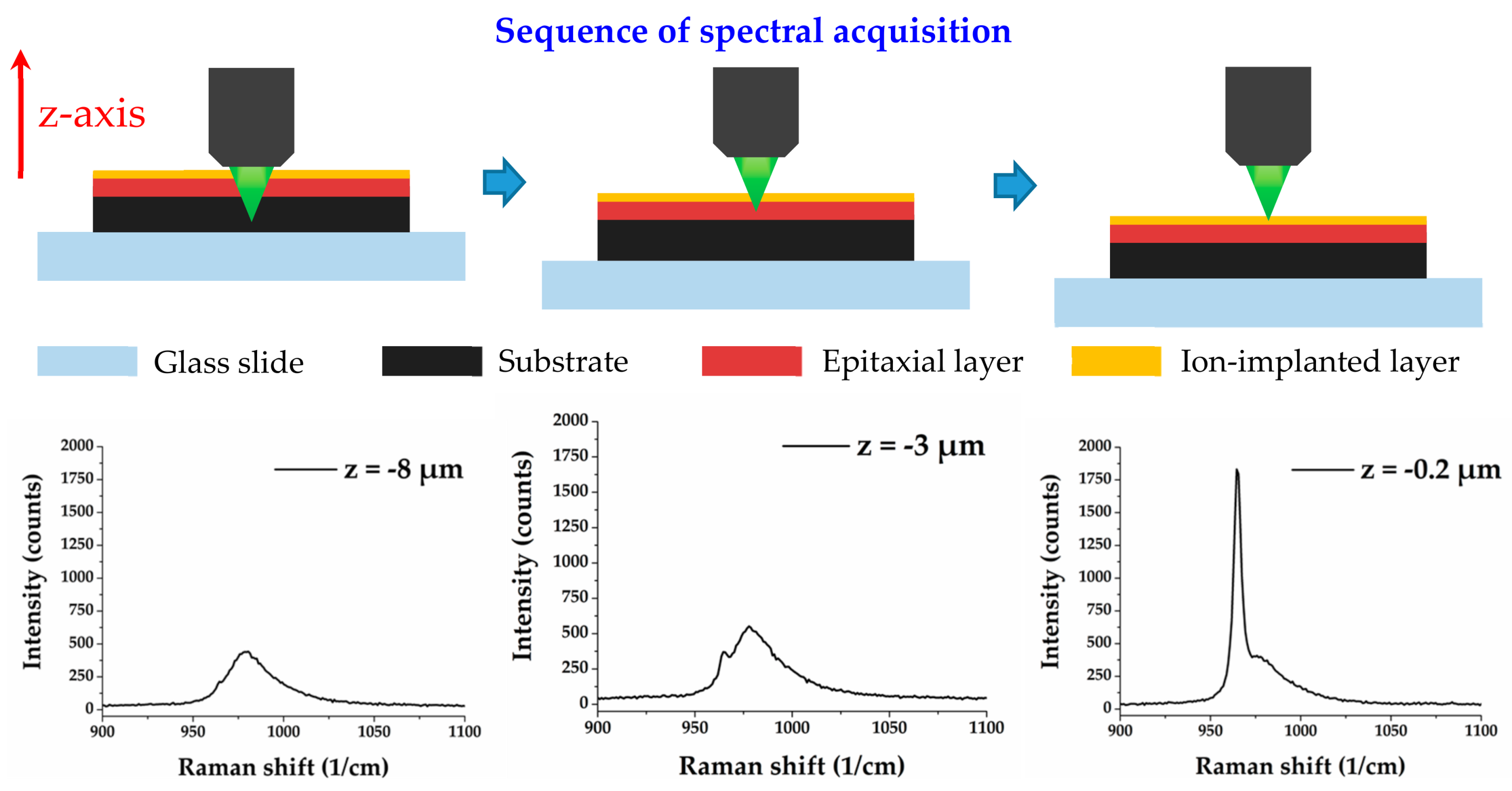
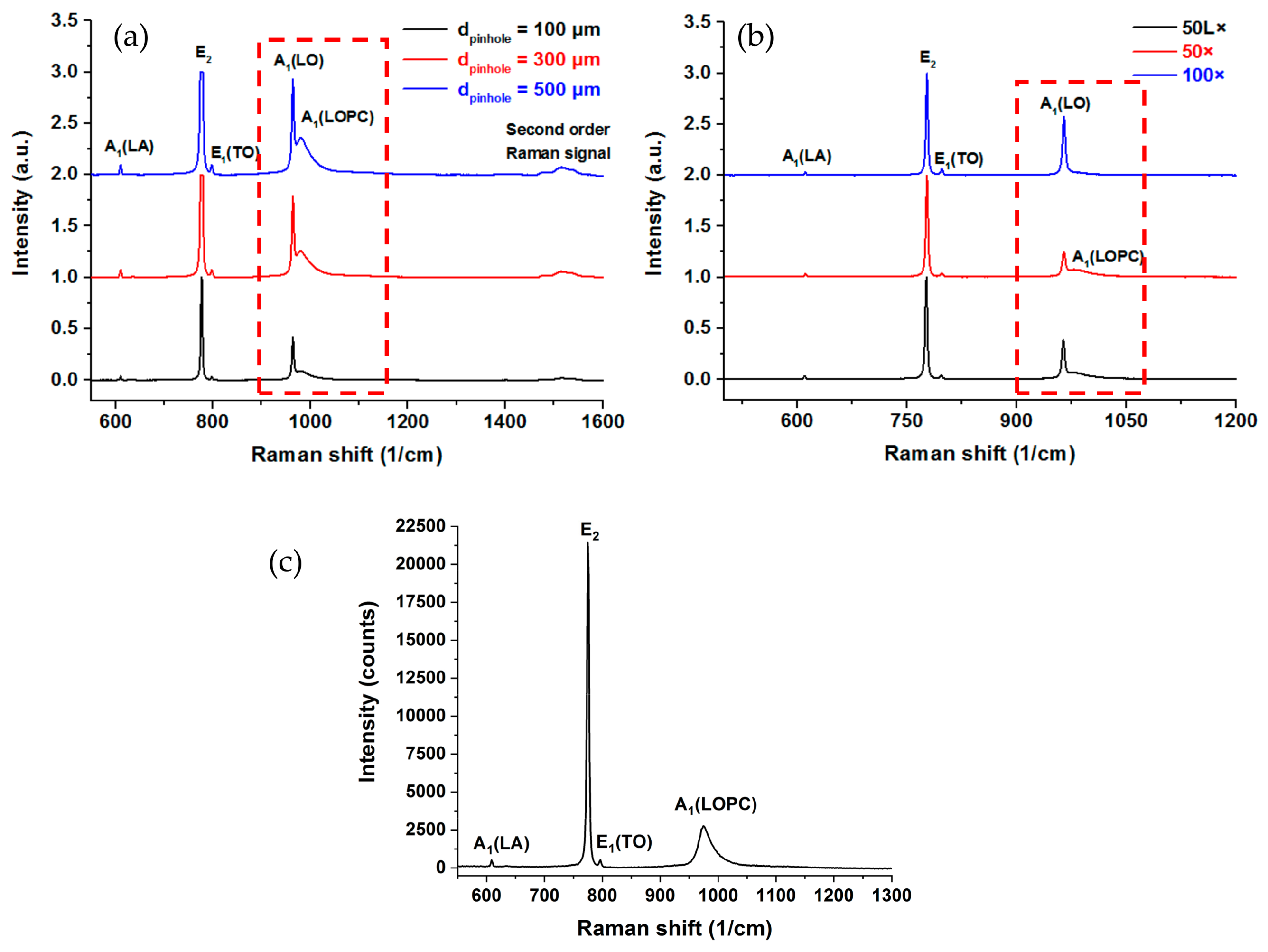
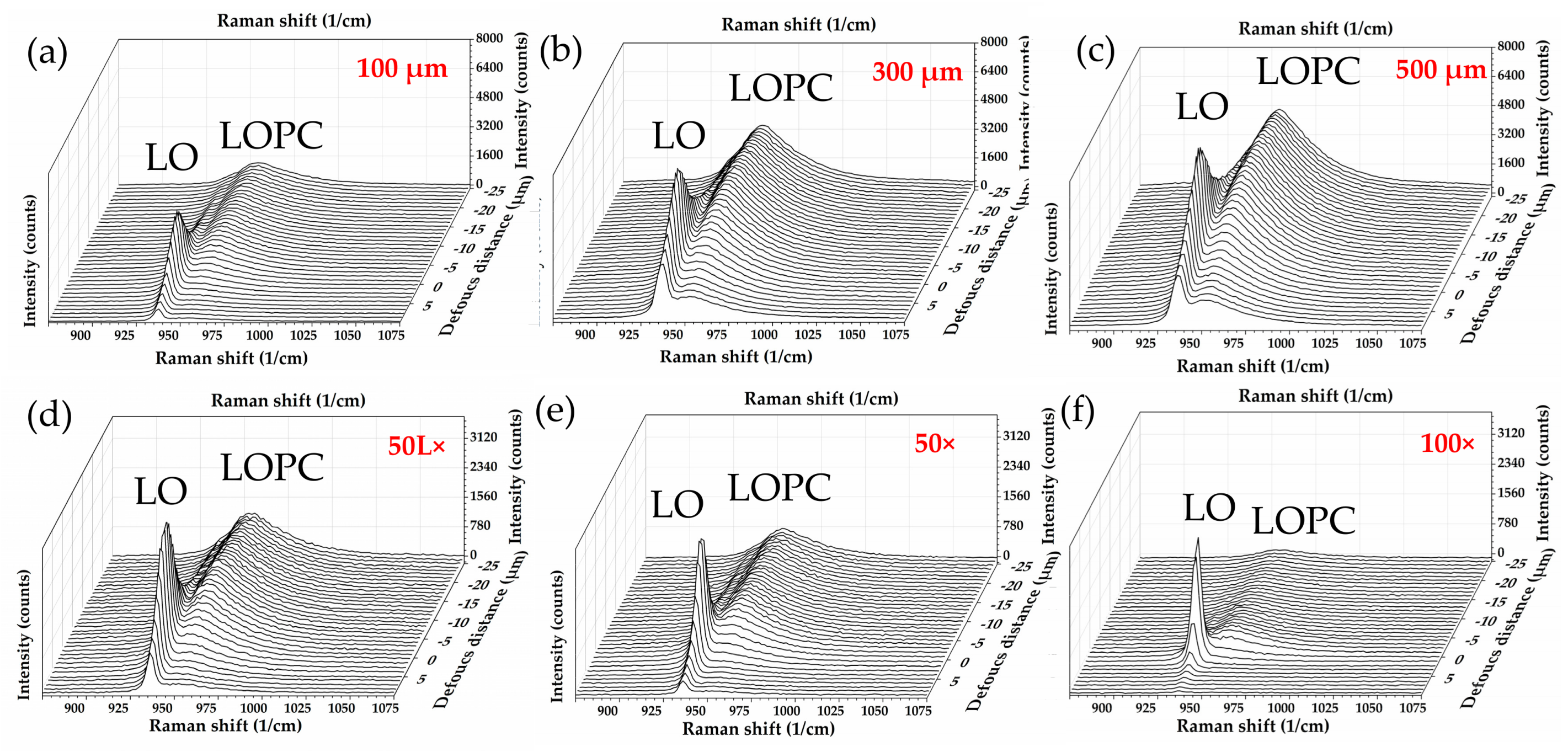
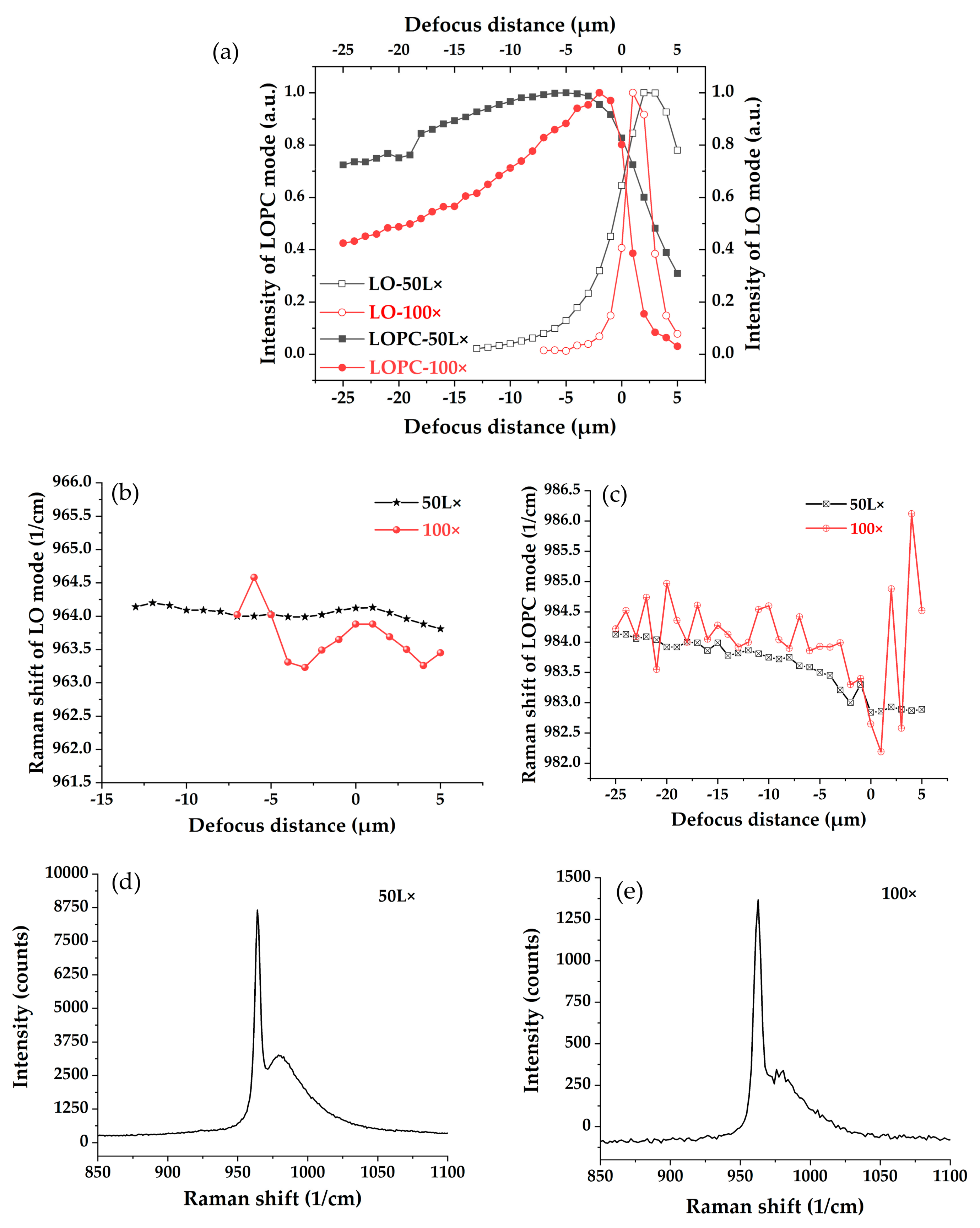

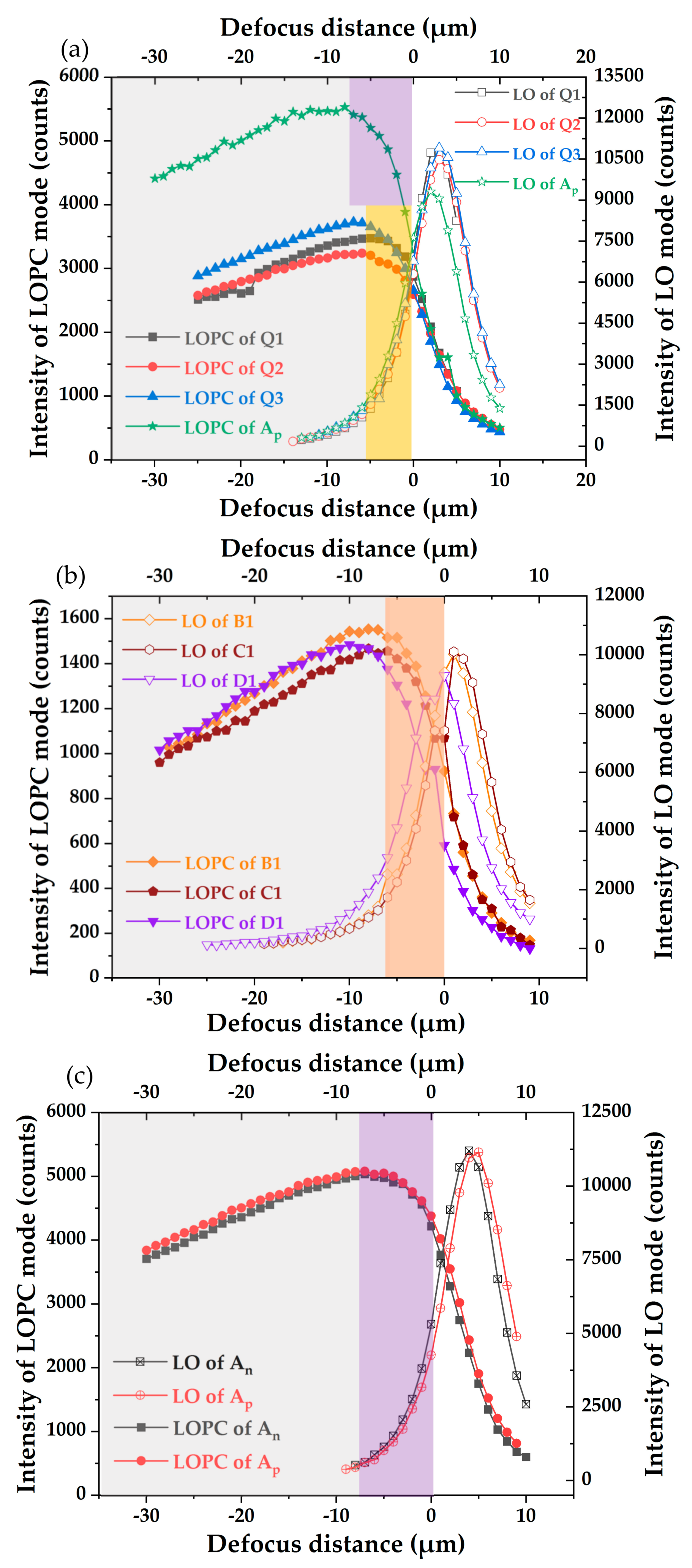

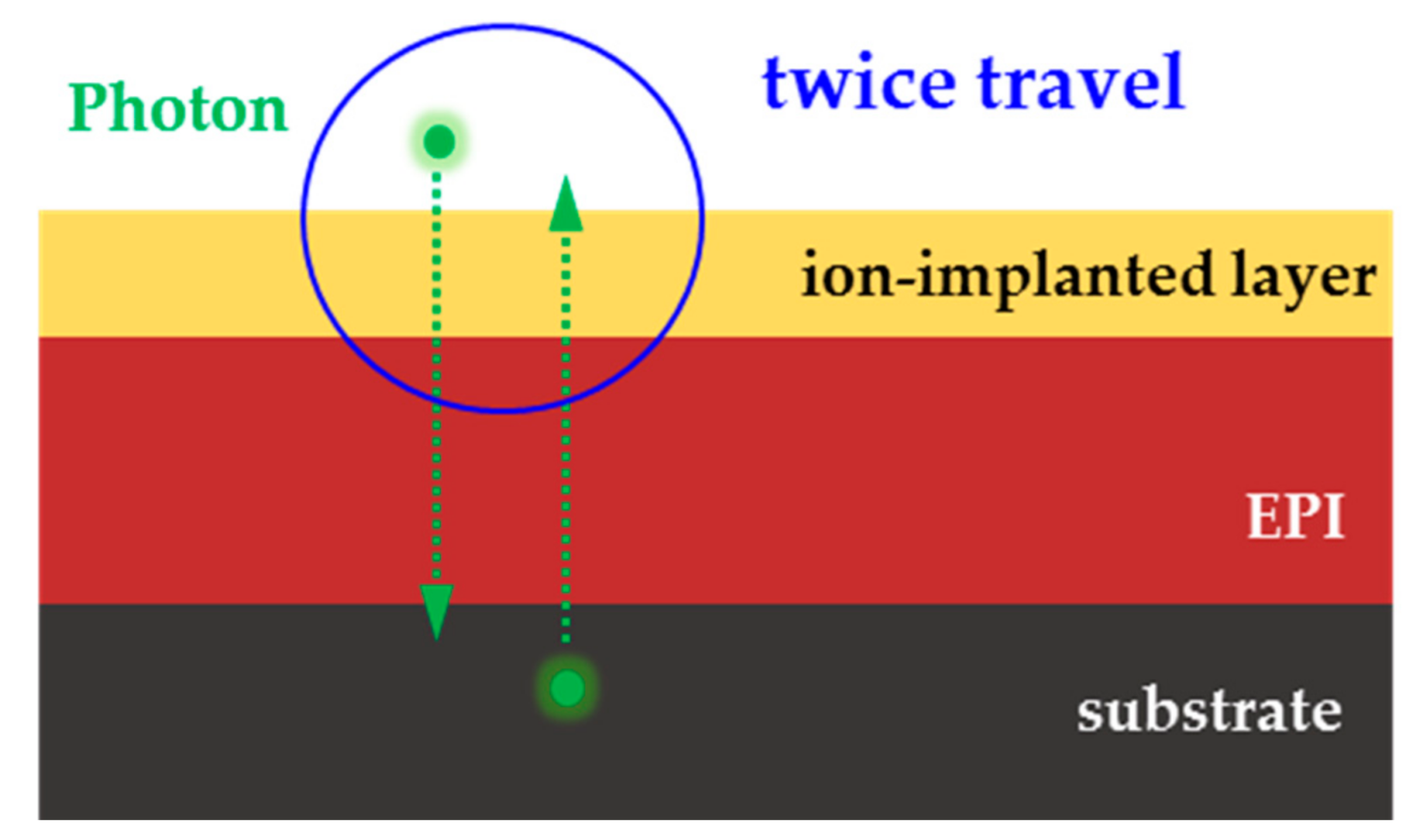
| Sample | Epitaxy | Implantation | Annealing | |||
|---|---|---|---|---|---|---|
| Label | Carrier Concentration (cm−3) | Thickness (μm) | Element | Surface Concentration (cm−3) | Temperature (°C) | Time (min) |
| G | ≈6.0 × 1015 | ≈5.3 | -a | - | 1700 | 30 |
| Q1 | ≈6.0 × 1015 | ≈5.3 | Al | 5.0 × 1016 | 1700 | 30 |
| Q2 | ≈6.0 × 1015 | ≈5.3 | Al | 5.0 × 1017 | 1700 | 30 |
| Q3 | ≈6.0 × 1015 | ≈5.3 | Al | 1.0 × 1018 | 1700 | 30 |
| A | ≈1.4 × 1016 | ≈7.5 | N | 5.0 × 1019 | 1700 | 30 |
| ≈1.4 × 1016 | ≈7.5 | Al | 5.0 × 1019 | 1700 | 30 | |
| B1 | ≈1.0 × 1016 | ≈6 | Al | 3.3 × 1018 | 1700 | 30 |
| B2 | ≈1.0 × 1016 | ≈6 | Al | 5.0 × 1019 | 1700 | 30 |
| C1 | ≈1.0 × 1016 | ≈6 | Al | 3.3 × 1018 | 1800 | 30 |
| C2 | ≈1.0 × 1016 | ≈6 | Al | 5.0 × 1019 | 1800 | 30 |
| D1 | ≈1.0 × 1016 | ≈6 | Al | 3.3 × 1018 | 1900 | 1 |
| D2 | ≈1.0 × 1016 | ≈6 | Al | 5.0 × 1019 | 1900 | 1 |
| Sub b | - | - | - | - | - | - |
| Objective | N.A. a | WD b (mm) | Half-Entrance Angle θ c (deg) | Depth of Focus ω (μm) | Pinhole Diameter (μm) | ||
|---|---|---|---|---|---|---|---|
| 500 | 300 | 100 | |||||
| Depth Resolution d (μm) | |||||||
| 50× | 0.75 | 0.37 | 48.6 | 0.4 | 6.0 | 3.0 | 1.5 |
| 50L× e | 0.5 | 10.6 | 30.0 | 1.6 | 14 | 8.0 | 3.0 |
| 100× | 0.9 | 0.21 | 64.2 | 0.1 | 3.0 | 1.2 | 0.7 |
| Label | Interface Position Measured by FTIR (Thepi/μm) | Average Position of LOPC Intensity maximum (x/μm) | Standard Deviation of the Average Position (δx/μm) | Deviation of Raman Depth Profiling (Δ/μm) |
|---|---|---|---|---|
| Q1 | –5.3 | –7.1 | 0.4 | –1.8 |
| Q2 | –5.3 | –6.3 | 0.4 | –1.0 |
| G | –5.3 | –7.6 | 0.1 | –2.3 |
| B1 | –6.0 | –6.7 | 0.2 | –0.7 |
| B2 | –6.0 | –7.9 | 0.1 | –1.9 |
| C1 | –6.0 | –7.0 | 0.5 | –1.0 |
| An | –7.5 | –8.6 | 0.4 | –1.1 |
| Ap | –7.5 | –9.1 | 0.2 | –1.6 |
© 2020 by the authors. Licensee MDPI, Basel, Switzerland. This article is an open access article distributed under the terms and conditions of the Creative Commons Attribution (CC BY) license (http://creativecommons.org/licenses/by/4.0/).
Share and Cite
Song, Y.; Xu, Z.; Liu, T.; Rommel, M.; Wang, H.; Wang, Y.; Fang, F. Depth Profiling of Ion-Implanted 4H–SiC Using Confocal Raman Spectroscopy. Crystals 2020, 10, 131. https://doi.org/10.3390/cryst10020131
Song Y, Xu Z, Liu T, Rommel M, Wang H, Wang Y, Fang F. Depth Profiling of Ion-Implanted 4H–SiC Using Confocal Raman Spectroscopy. Crystals. 2020; 10(2):131. https://doi.org/10.3390/cryst10020131
Chicago/Turabian StyleSong, Ying, Zongwei Xu, Tao Liu, Mathias Rommel, Hong Wang, Yufang Wang, and Fengzhou Fang. 2020. "Depth Profiling of Ion-Implanted 4H–SiC Using Confocal Raman Spectroscopy" Crystals 10, no. 2: 131. https://doi.org/10.3390/cryst10020131
APA StyleSong, Y., Xu, Z., Liu, T., Rommel, M., Wang, H., Wang, Y., & Fang, F. (2020). Depth Profiling of Ion-Implanted 4H–SiC Using Confocal Raman Spectroscopy. Crystals, 10(2), 131. https://doi.org/10.3390/cryst10020131






